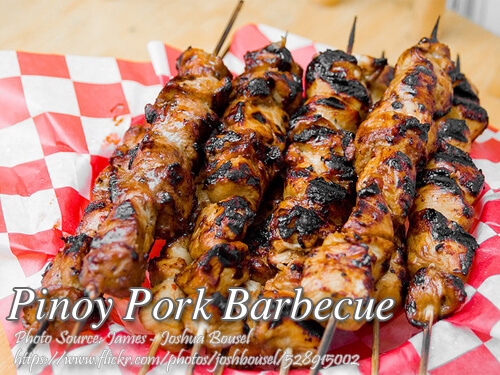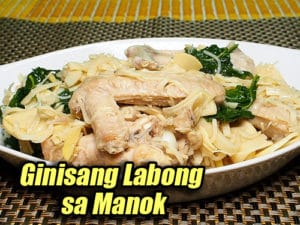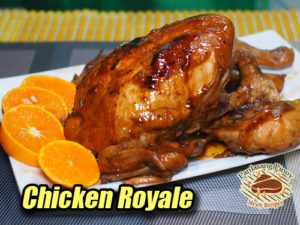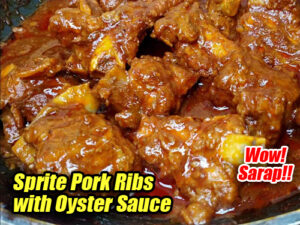When I see pork barbecue in bamboo skewers or sticks, I always assume it is a Filipino pork barbecue. Anyway this recipe is the common pinoy barbecue specially the pork barbecue marinade that usually contain 7-up or sprite instead of using only sugar. I think it also acts as meat tenderizer.
Some people use beer instead of softdrinks or soda to give the barbecue meat more savory flavor and to tenderize the meat. The marinade is a simple mixture of soy sauce, sugar, calamansi juice, 7-up or sprite, crushed garlic, pepper and salt. You can omit the salt because soy sauce is already salty. Since garlic is the only spice that gives this barbecue it’s savory flavor, I tried to put the marinade mixture in a blender to puree the garlic and assume it will give the barbecue a more savory flavor. I think it works but the only problem is when grilling the meat on charcoal. It easily burns the meat and leaves a very thick black soot on the grill. So I went back to crushed garlic when making the marinade.
Filipino Pork Barbecue: A Taste of Home on a Stick
Filipino pork barbecue has a way of tugging at my heartstrings. The sight of marinated pork skewered on bamboo sticks, sizzling over glowing charcoal, instantly transports me back to my childhood in Pampanga. I can still hear my Tito Ben hollering for us to grab a plate while my cousins and I eagerly lined up for a freshly grilled stick, smoky and glistening with its sweet-savory glaze.
This humble yet iconic dish holds a special place in many Filipino celebrations—be it birthdays, fiestas, or simple family gatherings. Beyond its delicious taste, it represents a sense of community, the joy of sharing, and the magic of turning simple ingredients into something unforgettable.
The Secret to Perfect Filipino Pork Barbecue
The beauty of Filipino pork barbecue lies in its marinade—a blend of flavors that is as simple as it is ingenious. My Tita Mila swore by adding 7-Up or Sprite, not just for its sweetness but also for its ability to tenderize the meat. The soda’s carbonation works its way into the pork, breaking down proteins for that melt-in-your-mouth texture.
For those seeking a bolder flavor, beer can be used as a substitute. My brother, a self-proclaimed barbecue connoisseur, once experimented with lager, and the result was a deeper, slightly bitter edge that balanced the marinade’s sweetness perfectly.
At its core, the marinade consists of soy sauce, sugar, calamansi juice, crushed garlic, salt, and pepper. Each ingredient plays its part: the soy sauce brings umami, the calamansi adds a citrusy zing, and the sugar provides that caramelized crust we all love. For a smoother, more concentrated flavor, I once pureed the garlic with the rest of the marinade in a blender. While the flavor was undeniably punchy, I quickly learned the downside—blended garlic tends to burn faster on the grill, leaving the meat with a sooty char. So, I’ve since returned to the tried-and-true method of using crushed garlic.
Mastering the Grill of Filipino Pork Barbecue
Grilling Filipino pork barbecue over live charcoal is an art form in itself. The intense heat from the coals ensures a beautifully charred exterior while keeping the meat juicy inside. My Lolo Tomas always said that flipping the skewers often and brushing them with a mixture of banana ketchup and oil was the key to that signature glossy finish.
Banana ketchup, a uniquely Filipino condiment, lends a tangy-sweet flavor that balances the savory marinade. The oil, meanwhile, helps prevent the meat from drying out and keeps it from sticking to the grill. As the skewers sizzle, the aroma is nothing short of intoxicating—a perfect blend of smoke, sweet caramelization, and garlicky goodness.
A Dish Steeped in History
Filipino pork barbecue traces its roots to the country’s rich culinary history. Barbecue itself was introduced to the Philippines through various cultural influences, from early Malay settlers to the Spanish colonizers. Over time, Filipinos adapted the dish to suit their palates, incorporating local ingredients like calamansi and banana ketchup.
The use of bamboo skewers, for instance, harks back to traditional methods of cooking in the Philippines, where simplicity and practicality are highly valued. Whether sold by street vendors or served at family reunions, pork barbecue remains a symbol of Filipino ingenuity and love for communal eating.
Tips for Beginners
If you’re new to making this barbecue, don’t fret—it’s a forgiving recipe that welcomes experimentation. Just remember to let the pork marinate overnight. This step is crucial for infusing the meat with all the bold, vibrant flavors of the marinade.
When skewering the pork, leave a little space between each piece to ensure even cooking. And don’t rush the grilling process; cooking over medium heat allows the pork to cook through without burning the outside.
For those without access to live charcoal, a stovetop grill pan or oven broiler works in a pinch. However, nothing quite compares to the smoky, slightly charred flavor imparted by real charcoal.
Food for Thought
Did you know that in some parts of the Philippines, pork barbecue is also served as pulutan, or bar chow? It pairs wonderfully with a cold glass of beer, making it a popular choice for late-night gatherings with friends.
Even more fascinating is how regional variations of pork barbecue have emerged over the years. In Cebu, for example, the marinade often includes a hint of vinegar for a tangier flavor. These subtle differences reflect the diverse culinary landscape of the Philippines, making each skewer a little window into the country’s rich food heritage.
A Dish to Bring People Together
Whether you’re grilling for a family reunion, a backyard party, or simply craving a taste of home, it is a dish that never fails to deliver. Its sweet, smoky, and savory flavors are a reminder of the simple joys of life—good food, great company, and the warmth of Filipino hospitality.
So, gather your ingredients, fire up the grill, and let the aroma of pork barbecue fill the air. You might just find yourself reminiscing about your own childhood memories or creating new ones to cherish. After all, every skewer tells a story, and every bite brings a little piece of home.
How To Make Filipino Pork Barbecue
Ingredients
- 1 kilo pork butt or pork shoulder sliced thin into 1 1/2 inch square and 3/4 inch thick.
- 1 big head garlic crushed
- 1/2 cup 7-Up or Sprite
- 2 tsp. fine salt
- 2 pcs big calamansi extract the juice
- 1 tsp. black pepper
- 2 Tbsps. soy sauce
- 2 Tbsps. sugar
Instructions
How To Make Filipino Pork Barbecue
- Mix all the ingredients together including the pork.
- Marinate overnight in the refrigerator.
- Skewer 3 to 4 pcs. of pork in each stick. Cook over live charcoal until almost done.
- Brush with catsup mixed with 1/2 cup oil. Cook until done.
- Serve hot. Makes 20-22 sticks.
Notes
Cooking Tips:
Marinate Overnight for Maximum Flavor
To achieve the bold and savory-sweet taste that defines Filipino pork barbecue, marinate the pork overnight. This gives the meat enough time to absorb the flavors from the soy sauce, calamansi, sugar, and spices, ensuring every bite is seasoned to perfection. A longer marination time also helps tenderize the meat, making it juicy and flavorful after grilling.Use Live Charcoal for Authentic Smokiness
Grilling over live charcoal is essential for achieving the authentic smoky flavor that sets Filipino pork barbecue apart. The charcoal imparts a unique aroma and charred texture that you can’t replicate with gas or electric grills. Keep the heat medium to high and flip the skewers often to ensure the meat cooks evenly without burning.Brush with Banana Ketchup for a Glossy Finish
Banana ketchup is a must when grilling Filipino pork barbecue, as it adds a sweet, tangy glaze that balances the savory marinade. Mix it with a bit of oil before brushing it onto the skewers to keep the meat moist and prevent it from drying out. Apply the ketchup glaze in the last few minutes of grilling to avoid burning and to achieve that signature caramelized coating.






Hi Liza, thanks for visiting the site and I’m happy that you found the barbecue recipe for your hubby’s birthday.
Hello Sir,thanks For the recipe.i’l do this tomorrow For 20 guests.its My hubby’s birthday.i am one of ur follower….more power and God bless!…😊😊😊 greetings from italy.
Thanks Andrea for visiting this blog. I’m sure you will do it perfectly. Cheers!
Missing Pinoy food. Definitely looking forward to this tonight. First time to cook it, hope i do get it right. Greetings from Austria.
You are very welcome Ryan.
Thank you for the response.
2 big calamansi juice?
Big cup? Big spoon?
Hi Ryan,
Sorry for the typo, it should be 2 big calamansi, extract the juice.